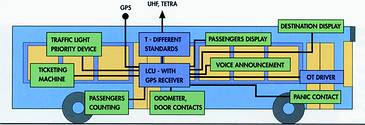
In addition to marketing Satel Satelline products for several years, Comatis has developed versatile radio communications infrastructure to complement its range of products. The Condor from the French company Comatis is a multicell platform for wireless data communication intended for vehicle fleet management and other similar duties. Information from several sources, fixed or mobile, is collected at one point, allowing the user to control and manage processes in realtime.
Combined with Satel's Satelline radio modems, the Condor offers the customer top-level telecommunication solutions for use in a wide range of applications that require management of information. The infrastructure supports all the main mobile communication networks, including GSM/GPRS, digital PMR, Trunk, TETRA, TETRAPOL, etc. The system is easily expandable to meet the needs of passenger information management for a fleet of any size.
Multitask management
The Condor network is a multicell data communication platform dedicated to realtime data transmission between large numbers of fixed and mobile subscribers and a central operating station. It comprises several client application systems connected to the radio data controller (RDC) server. The RDC is a realtime server that allows communication through the different radio media and provides connection to the application software modules via a TCP/IP network. The RDC manages several client connections simultaneously, and can be easily changed in terms of number of cells or supported radio media.
The data traffic is routed through radio front-end units (RFU), which are full duplex transceiver base stations usually installed on high points. In the Public Transportation Management and Information system, the RFUs support two-way communications with mobile and fixed points, like buses and bus stops. Buses are equipped with LCU (location and communication unit) on-board computers and fixed points with CCU (computing and communication unit) computers. The data traffic is carried out by a radio link that enables a low-cost connection between various RFUs and the RDC server.
The Condor in action
The Condor network can be used for a variety of tasks in fleet management. The application areas include public transportation, emergency and police services, transportation and delivery of goods, power and water distribution, among others. The network continuously collects data, which can be used in several ways. The most basic application is the surveillance of the status, location, speed or orientation of the buses. The system can also be used for alarm transmission from the vehicles or fixed points if the operation of the vehicle is disrupted or it deviates from the set course, misses a bus stop, or breaks down.

The two-way messaging system can be used to address single vehicles or the whole fleet. It can be used for different purposes from passenger information transmission to assigning waiting times at the bus stops. The system also works between the mobile and fixed units, which improves the updating of information displays on the buses.
The data can be transferred between mobile and fixed equipment and the central station, which means that accurate realtime timetable data can be sent to bus stops. In addition the passenger-capacity data from bus stops can be used to re-route buses to accommodate to the current need of transport capacity.
The selection of the data transfer means is automatic and can change according to the situation, meaning that the same vehicle can be successively tracked on the GSM, TETRA, satellite, etc, if needed. This also functions as an automatic backup in case of failure in one system.

The information interchange between the various levels of the Condor network are based on protocols specifically developed for mobile applications. These protocols use various radio channel access modes, depending upon their requirements. The dynamic TDMA mode guarantees the performance and time stability of the system as it distributes the load through various radio channels. If the whole bandwidth needs to be allocated to one application, it is possible to use the CSMA or point to multipoint mode.
For more information contact Satel SA, 011 887 2898.

© Technews Publishing (Pty) Ltd | All Rights Reserved